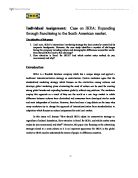Although some improvements are observed in ROCE in 1996 and 1997, so high negative ROCE in the last two years is not only a clear indication of the company’s capital investments are inefficient and unprofitable but also company is having a very poor financial performance and it is bleeding so much.
To upside-down the current poor financial problems, Laura Ashley appointed Ann Iverson and David Hoare June respectively between June 1995 and February 1999, however both could not be a remedy for the company to stop the financial losses.
In April 1998, 40% of Laura Ashley’s equity sold to MUI Group for £43.5million and £7.9million was raised from the sale of shares in Laura Ashley Japan. However, this cash inflow had been drained away by debt repayment, restructuring and closure costs, and continuing operating losses. The North America operations played a major role in these continuing operating losses. Iverson put emphasis on the North American market as a vehicle for top line growth and profit improvement and speeded up the openings of new stores in the continent. On the other hand, her successor Hoare began undoing much of the previous strategy and restructured the North American store portfolio by closing smaller stores and opening larger stores. The decline in Laura Ashley sales in 1998 and negative profits in 1997 and 1998 show that this strategy was not able to bring operational profits in the North American market. Now that the recovery program would require £20million for store closes and £6.5million is needed to upgrade the logistics and information systems.
The goal of the company is very simple “to survive”.
-
In order to survive, there is only one option in front of the company; leaving from the North America Market. The company cannot get any more loss in current situation. They have already tried two times in North America, and they collapsed in both of them. Also, the company does not have enough resource right now. As a result of this, MOI should invest £26.5 million to Laura Ashley. £20 million is for store closures, and £6.5 million is needed to upgrade its logistics and information systems. On the other hand, inventory turnover rate is the lowest one among the competitors, so the company can improve it by using the £6.5 million for it. Analyzing SGA/sales ratio of L.A. and its competitors, our company has the highest value. As a result of the store closures, it will decrease as well.
-
Firstly, what the company faces is costs resulted from excessive inventory. Faced with an unprecedented number and variety of products on the market, managers find it more difficult to predict demand and plan production and orders accordingly. As a result, inaccurate forecasts are increasing and, along with them, the cost of those errors. A new approach to the entire forecasting, planning, and production process, accurate response entails first figuring out what forecasters can and cannot predict well. Then supply chains must be made fast and flexible so that managers can postpone decisions about their most unpredictable items until they have some market signals like early-season sales results to help correctly match supply with demand. In order to forecast demand of new products, these products can be sent to retail stores in small batches and then supervisors that work in these stores can inform the company about sales of new products daily via internet or another computerized program, so by looking past data the company can make reliable forecasts on demand for new products. Moreover, in last years, there is no detailed market research that the company conducted. The new market research can be conducted about preference of American consumers. If the company combines the data from past sales and market research, it can reach more reasonable demand forecast.
As it is stated by Ann Iverson, there is a potential audience of over 19 million female shoppers in USA. Especially, there is a major opportunity in North America for lifestyle brands aim at 30-50 year old customers. In order to capture this opportunities, the company can turn back the North America market after a while. According to preference of those customers, products should be designed. For UK, Continental Europe and other areas, older strategies can remain same. In case of decrease in sales, new strategies (accurate response, market research) that are followed in North America can be applied in these areas.







